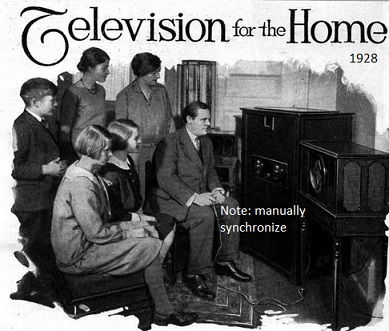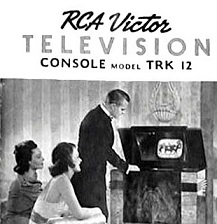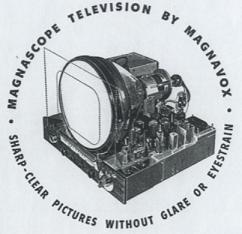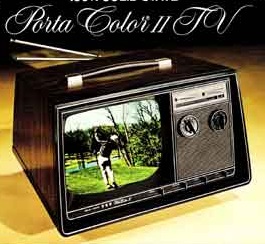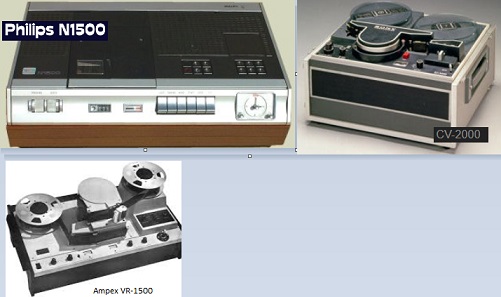A Brief History of TelevisionHistory | Editor(Copyright © 1999 Piero Scaruffi) |
|
See also the History of the Radio
TelevisionThe principle of the television camera was studied by the Russian-born Westinghouse scientist Vladimir Zworykin, who in 1923 called "iconoscope" the electron scanning tube (not built until 1933), and by Philo Farnsworth, who had been the first to demonstrate television broadcasting in September 1927 in San Francisco.
Two inventors had already demonstrated mechanical (not electronic) sets before 1927: John Baird in Britain and Francis Jenkins in the USA (the same man who had co-invented the film projector later acquired by Edison). Jenkins had given the first public demonstration of television in 1925. Jenkins also started the first television station, W3XK, in July 1928 near Washington, broadcasting to buyers of his (mechanical) "radiovisors" that used a rotating disk to visualize the images received via radio (15 images per second with a maximum resolution of 60 lines per image).
General Electric and AT&T introduced their own mechanical television sets (and General Eletric opened its own station). GE's demonstration in 1927 used both radio and telephone to send the images.
By 1930 there were therefore several television sets available, but none electronic.
Meanwhile, Farnsworth never found the capital and the sponsors to turn his (fully electronic) invention into a major appliance. The villain, again, was David Sarnoff, RCA's ruthless tyrant and lobbyist, who, realizing how television could kill radio, first pressured the government into passing regulations that slowed down progress in the new field and then invested massively in developing his own technology, even going to the extent of crediting his engineer Vladimir Zworykin with the invention of electronic television (whose first demonstration took place in 1935). The limitations of Jenkins' mechanical technology, the lack of funding for Farnsworth's independent laboratories, the Great Depression and the FCC's regulations dealt a deadly blow to the nascent industry in the USA. Both Jenkins' and DeForest's technology were acquired by RCA. Meanwhile, in Britain the BBC used Baird's technology for its television broadcasts between 1929 and 1936, and then EMI's electronic technology since 1936 (a technology based on RCA's). Baird introduced an electronic TV set only in 1935. In 1938 a RCA research center in New York received the television signal broadcasted by BBC 5,000 kms away. In Germany Telefunken applied Ferdinand Braun's cathode ray tube (CRT), a vacuum tube that can display images, to the television set, and started selling TV sets with CRTs in 1934. Germany displayed its electronic television system during the Olympics of Berlin in 1936. RCA, GE, Philco, Zenith and CBS rapidly learned how to replace Jenkins' spinning disks with electron scanning in order to provide a much higher quality of images, which also allowed for bigger screens.
Finally, in 1939 Sarnoff was ready to announce to the world (at the New York World's Fair) that RCA had "invented" television and later broadcasted Franklin Roosevelt to the whole nation (the first time that every corner of the nation could see its president not only on paper), blissfully ignoring the fact that Farnsworth still owned the patent for electronic television. The 12"-monitor TRK12 was not a commercial success but made television popular because 20 million people visited the World's Fair. The few hundred people who actually purchased a TRK12 saw from home the British king and queen visiting the fair. Weeks later RCA started the station W2XBS that broadcast the first variety show and the first televised sports event (a baseball game).
Sarnoff used the money and the power (and the attorneys) of RCA first to cripple television when people like Jenkins could have created a new colossal industry and then to steal the winning technology from Farnsworth who was its legitimate owner. For a while the makers of television sets were simply the makers of radio, which automatically made RCA the leader in sales of television sets. By then both Jenkins and Farnsworth had gone out of business. Sales of television sets languished because the monitors were too small, the programming was very limited, and the competition of cinema was colossal. Philco opened its own station, W3XE, in Philadelphia and in 1940 broadcasted live the convention of the Republican Party, that was being held in that city, also transmitted by telephone cable to New York and broadcasted by RCA's W2XBS station for its New York audience. Because there was no equivalent of RCA or Philco in Chicago, the Democratic Part's convention (held in Chicago) was not broadcasted live. RCA (1929), CBS (1931), RCA's subsidiary NBC (1939) and many others launched experimental programming until in 1941 the government legitimized the new technology choosing a nationwide standard, NTSC (National Television System Committee). In 1941 NBC and CBS launched the first commercial stations from New York. RCA benefited the most from World War II, thanks to the army's insatiable appetite for radios, second only to AT&T and GE in military contracts for electronics. The war was also a bonanza for Motorola, where in 1940 Henry Magnuski had produced the world's first walkie-talkie, the SCR-300 (actually heavy enough that needed a backpack). The army loved the idea of the hand-held two-way radio transceiver and Motorola manufactured a smaller (truly hand-held) version, the SCR-536, that became ubiquitous during the war. With that army money Sarnoff opened the RCA Laboratories in New Jersey near Princeton University (and therefore near Bell Labs). In 1947 RCA launched the 630TS set that truly generated a mass market because RCA made it "open source": it let competitors copy the design and sell their own version of it.
Magnavox introduced its first TV set in 1948.
Paramount entered television broadcasting in 1943 and in 1949 it became the first major studio to offer program syndication. In 1946 there were only six thousand television sets in the USA (all of them in New York's metropolican area). By 1949 that number had skyrocketed to three million in many more cities, and it more than doubled in 1950, and then it decupled in the following decade reaching to 52 million in 1960. Movie attendance started dropping proportionally (80 million tickets a week in 1946, 60 million in 1950 when the USA had 11,300 movie theaters plus 4,700 drive-in theaters, and less than 40 million in 1960). In 1950 RCA was a leader in all three categories: tubes, TV sets and broadcasting. The only serious competitor in broadcasting was CBS. The only serious competitor in vacuum tubes was Sylvania (although CBS would purchase Hytron in 1951, a Boston-based manufacturer of tubes, the world's fourth largest). The main competitors in TV sets were Philco, Zenith and Motorola. Motorola had introduced in 1948 a very popular model, the portable 7"-monitor "Golden View".
Zenith, the pioneer of portable radios, moved into TV sets in 1948 and invented the remote control in 1956, Electromechanical color televisions had been invented in 1940 by both John Baird in Britain and Peter Goldmark at CBS, but the FCC banned color television because it was not compatible with the government-mandated standard, i.e. RCA's television system. However, CBS was vindicated a decade later when the FCC picked its improved (fully electronic) system over RCA's. CBS' first color broadcast took place in 1951, but RCA was the only manufacturer of color sets. RCA used all its power to overturn the decision if the FTC In 1951 RCA also introduced the world's first portable battery-operated camera, and a tricolor tube that they offered as "open source". In 1951 the transcontinental television link between New York and San Francisco took place via 107 radio-relay stations. Color television remained a novelty until the end of the decade. There were no major programs filmed in color until NBC's "Bonanza" in 1959. A well-intentioned lawsuit by the US government in 1958 against he quasi-monopolies of IBM, AT&T and RCA resulted, ironically, in RCA focusing on the foreign markets, the only ones to which RCA was still allowed to charge for its technology. In other words, it resulted in an involuntary transfer of know-how from RCA to European (e.g. Philips) and Japanese competitors. The antitrust lawsuit did not save RCA's competitors: Philco acquired by Ford in 1961, and Sylvania merged with General Telephone in 1958, becoming General Telephone & Electronics (GTE). Finally, NBC decided to go all color in 1965, and its competitors ABC and CBS had no choice but to follow suit. The national TV stations of Britain and West Germany began color transmissions in 1967. GE's cheap and portable 11"-monitor Porta-Color set of 1966, designed by Paul Pelczynski, made color television affordable for the masses.
The television documentary "An American Family" (1971) followed the Lourd family, a middle-class family, and inaugurated the "reality show". In november 1972 Charles Dolan and Gerald Levin launched the first pay-television network, Home Box Office (HBO). In 1976 Ted Turner created the first basic cable network (using a satellite), WTCG (later WTBS), based in Atlanta. In 1980 Turner launched CNN, the first cable television service devoted to world news. Final deregulation came in 1984 with the "Cable Act". Cable subscribers skyrocketed to more than 50 million by 1989. The VCRThe age of the videotape began in earnest in 1956, when Ampex, the manufacturer of magnetic tape recorders, introduced the Quadruplex videotape format and the VRX-1000 videotape recorder, which made it possible to record one hour of broadcast-quality video on a reel of magnetic tape. It was trying to solve the problem of television networks, that had to record a program on the East Coast, ship it across the nation, and broadcast it a few hours later in other time zones. The existing methods (mainly the kinescope) were expensive, time-consuming and produced much worse quality than live broadcasting. Ampex solved their problem, and the first tape-delayed evening CBS News broadcast in November 1956 ("Douglas Edwards and the News" to West Coast stations, which had been recorded three hours earlier in New York) changed forever the way television was done. But the system was too expensive to be used by anyone else. In 1963 Ampex in the USA, Philips in the Netherlands, Sony in Japan and Telcan in Britain introduced cheaper and smaller videotape recorders. The Ampex VR1500 of 1963 and especially the Sony CV-2000 of 1965, developed by Nobutoshi Kihara's team, were the first videotape recorders that percolated into households.
Sony then introduced the videocassette with its U-matic system of 1971, and Philips responded with its Video Cassette Recording system of 1972 (better known as N1500). Two more Japanese companies entered the market: Matsushita and Panasonic, the latter mainly through its subsidiary Japan Victor Corporation (JVC). In 1975 Sony launched its standard Betamax, and in 1976 JVC responded with its standard VHS (Video Home System), that was soon backed by Matsushita and RCA. The JVC Victor HR-3300 of 1976 and the RCA VBT200 of 1977 were the first VHS models. VHS eventually won over Betamax, but, more consequentially, the Japanese industry won over RCA, a fact that de facto transferred leadership of consumer electronics from the USA to Japan. The videotape terrified the film studios so much that Universal Studios and Walt Disney sued Sony. In 1984, however, the Supreme Court of the USA ruled that home recording of television programs constituted "fair use", an important precedent in copyright law. The studios, as typical of large corporations, had totally missed the point: within a few years, the sale and rental of movie videos became one of their main sources of revenues. The videocassette started declining rapidly after the introduction of the DVD in 1997. The last VCR was manufactured in 2016 by Funai Electric in Japan. |
| (Copyright © 1999 Piero Scaruffi) |



